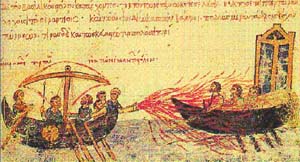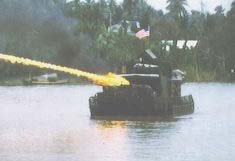Chemical Weapons - Greek Fire, Gunpowder, poisoned arrows
Biological Weapons, disease
Psychological Warfare, propaganda, superior weapons, huge
armour, noise, terror (Beziers, Heads)
Chemical Weapons - Greek Fire
Incentiary devices were standard weapons of war. Wooden defences always needed protection from burning. Wet animal hides were highly effective against burning arrows so military engineers dedicated themselves to finding ways of ensuring that fires burned as long and as strongly as necessary to catch. All sorts of chemicals could be used for this purpose - petroleum, sulphur, quicklime and tar barrels for example.
|
Liquid fire is represented on Assyrian bas-reliefs. At the siege of Plataea in 429 BC the Spartans attempted to burn the town by piling up against the walls wood saturated with pitch and sulphur and setting it on fire, and at the siege of Delium in 424 BC a cauldron containing pitch, sulphur and burning charcoal was placed against the walls. A century later Aeneas Tacticus mentions a mixture of sulphur, pitch, charcoal, incense and tow packed in wooden vessels, ignited and thrown onto the decks of enemy ships. Formulae given by Vegetius around AD 350 add naphtha or petroleum. Some nine centuries later the same substances are found and later recipies include saltpetre and turpentine make their appearance. The ultimate in this form of chemical warfare was called Greek-Fire. |
|
Greek fire was a burning-liquid used as a weapon of war by the Byzantines, and also by Arabs, Chinese, and Mongols. Incendiary weapons had been in use for centuries: petroleum and sulphur had both been in use since the early days of the Christianity. Greek fire was vastly more potent. Similar to modern napalm, it would adhere to surfaces, ignite upon contact, and could not be extinguished by water alone.
|
Byzantines used it in naval battles to great effect because it burned on water. It was responsible for numerous Byzantine military victories on land as well as at sea - and also for enemies preferring discretion to valour so that many battles never took place at all. It was the ultimate deterrent of the time, and helps explain the Byzantine Empire's survival until 1453. There was no defence. As the Lord of Joinvilleone noted in the thirteenth century "Every time they hurl the fire at us, we go down on our elbows and knees, and beseech Our Lord to save us from this danger." Men were known to simply flee their posts rather than face Greek Fire. On the other hand Greek fire was very hard to control, and it would often accidentally set Byzantine ships ablaze. Greek Fire is said to have been invented by a Syrian Engineer, one Callinicus or Kallinikos, a refugee from Maalbek, or an architect from Heliopolis in the Byzantine Province of Judaea, in the seventh century (673 AD). The formula for Greek fire was a closely guarded secret and it remains a mystery to this day. |
|
The term Greek Fire was not attributed to it until the time of the European Crusades. Some of the original names include Liquid Fire, Marine Fire, Artificial Fire and Roman Fire. (Muslims against whom the weapon was used called the Byzantines Romans).

![]() The
weapon was first used by the Byzantine navy, and the most
common method of deployment was to squirt it through a large
bronze tube onto enemy ships. Usually the mixture would
be stored in heated, pressurised barrels and projected through
the tube by some sort of pump, operators being protected
behind large iron shields. Byzantines used Greek Fire only
rarely, apparently out of fear that the secret mixture might
fall into enemy hands. The loss of the secret would be a
greater loss to Byzantium then the loss of any single battle.
The
weapon was first used by the Byzantine navy, and the most
common method of deployment was to squirt it through a large
bronze tube onto enemy ships. Usually the mixture would
be stored in heated, pressurised barrels and projected through
the tube by some sort of pump, operators being protected
behind large iron shields. Byzantines used Greek Fire only
rarely, apparently out of fear that the secret mixture might
fall into enemy hands. The loss of the secret would be a
greater loss to Byzantium then the loss of any single battle.
In 678 the Byzantines utterly destroyed a Muslim fleet - over 30,000 men were lost. In 717-718 Caliph Suleiman attacked Constantinople (Byzantium). Most of the Muslim fleet was once again destroyed by Greek Fire, and the Caliph was forced to flee. There is virtually no documentation of its usage after this time by the Byzantines and it is generally believed that it was during this era that the secret of creating Greek Fire was lost. Formulae used after this date never seems to have had the same devastating effect.
|
Some form of Greek Fire continued to be used for centuries. Byzantines used it against the Venetians during the Fourth Crusade. A so-called "carcass composition" containing sulphur, tallow, rosin, turpentine, saltpetre and antimony, became known to the Crusaders as Greek fire but is more correctly called wildfire. So far, no-one has been able to recreate Greek Fire. Arabian armies, who eventually created their own version sometime between the mid-seventh century and the early tenth. It was relatively weak copy of the original Byzantine substance, though still one of the most devastating weapons of the period. Arabs used the Greek Fire much like Byzantines, using brass tubes mounted aboard ships or on castle walls. They also filled jars with it, to be hurled by hand at their opponents. Arrows and javelins would be used to carry the mixture further and engines of war could be used to throw larger amounts over castle walls. As a defence, water alone was ineffective. On land sand could be used to stop the burning . Intriguingly it is also known that vinegar and urine were effective - suggesting an alkaline composition that could be neutralised by acid. According to some accounts pure or salt water served to intensify the burning, suggesting that Greek Fire may have been a 'thermite-like' reaction, perhaps involving quicklime. According to some sources, Greek Fire burst into flames on contact with water. Some have suggested phosphorus, Others have suggested a form of naphtha or another low-density liquid hydrocarbon (petroleum was already known in the East). There are numerous candidates including liquid petroleum, naphtha, burning pitch, sulphur, resin, quicklime and bitumen, along with a hypothetical unknown "secret ingredient". The exact composition is unlikely ever to be deduced from the inadequate surviving records. |
|
It is not clear from contemporary reports if the operator ignited the mixture with a flame as it emerged from the syringe, or if it ignited spontaneously on contact with water or air. If the latter is the case, it is possible that the active ingredient was calcium phosphide, made by heating lime, bones, and charcoal. On contact with water, calcium phosphide releases phosphine, which ignites spontaneously. The reaction of quicklime with water also creates enough heat to ignite hydrocarbons, especially if an oxidiser such as saltpetre is present.
Ingredients were apparently preheated in a cauldron, and then pumped through a pump or used in hand grenades. If a pyrophoric reaction was involved, perhaps these grenades contained chambers for the fluids, which mixed and ignited when the vessel broke on impact with the target.
More information
Professor J.R. Partington, A History of the Greek
Fire and Gunpowder, Heffer, 1960.







